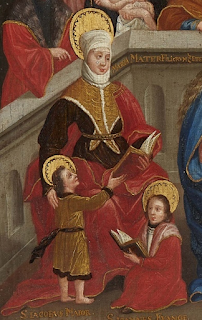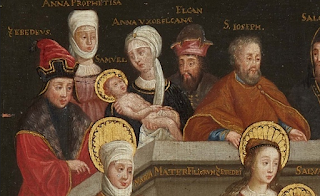Lempertz, from Germany, sells on 20 September 2019 a "Probably South German master, 16th century" Holy Kinship, estimated at 6,000 to 8,000 Euro.
While there are many somewhat similar works with this subject, sharing some aspects with the one here, I could only find one other work with nearly the same composition. Strangely enough, the execution of that one is quite different, and it was described at the auction in 2005 as "Circle of Anthuenis Claeissins", referring to the Bruges painter Anotnis Claeissens (1536-1613). I found that one through Artnet, and I have no idea of which auction house, estimate or result. They also only offer a relatively small image, which is too bad, but beggars can't be choosers I suppose.
The two paintings may look quite different at first sight, but too many details are the same to be a coincidence.
At the bottom left, we have Saint John the Apostle and Saint James the Great, with their mother Salomé. In both cases, Salomé has very similar headgear and mantle, the same position with the slightly opened book in one had and the other around the standing Jacob, and John sitting at her knees and reading.
The top left shows 6 important Biblical figures (plus a child), including Joseph, Salomon, and Zebedeus. The order and placement of the figures is identical, with e.g. Josephh standing with his hands on the balcony on either side of the head of Mary, Zebedeus on the left pointing to his wife Salome, or the two women directly to the right of Zebedeus, with the baby and the same headgear. As in all these comparisons, it will also be clear that the colours vary wildly, and that postures and details are sometimes very similar, and at other times completely at odds.
In the centre we get Mary and her mother Anna, and Jesus between them.These are less similar, but some details like the dress and headdress of Anna (and the way it falls over her shoulders), the hand in the open book, all point to the same origin.
At the top right we see six further figures (again with an extra child, John the Baptist), with Elizabeth, Simeon, Cleophas, and others. The three left-most figures, Salomon (labeled (Salomé in the painting), Simeon, and Joachim, have the same position and gestures, but by mistake has the bishops hat of Zacharias been given to Simeon in the Claeissens version (or vice versa). The figures on the right are less similar, although they are placed in the same order and e.g. the rightmodst one, Alphaeus, points to his wife Mary in both examples.
The bottom right has Mary Alphaeus, and 4 children; James (the son of Alpheus), Simeon (probably Simon the Zealot or Simeon of Jerusalem), Barnabas, and Judas Thaddeus. Striking similarities include the headdress of Mary, the position of all 5 figures (with Judas Thaddeus half kneeling, his head turned, one hand stretched out towards Jesus, and the other holding a basket; and Simeon and Barnabas together reading a book).
All in all, these similarities can not possibly be a coincidence, and point to a common origin for these two works. However, the clear differences seem to indicate that their have to have been intermediate versions, not one common origin (like an engraving), but e.g. two different drawings after some common work, which then formed the basis for these two paintings.
I haven't found a trace of these possible other (better) versions of this composition, nor of a possible original artist. Any and all information is welcome!












No comments:
Post a Comment